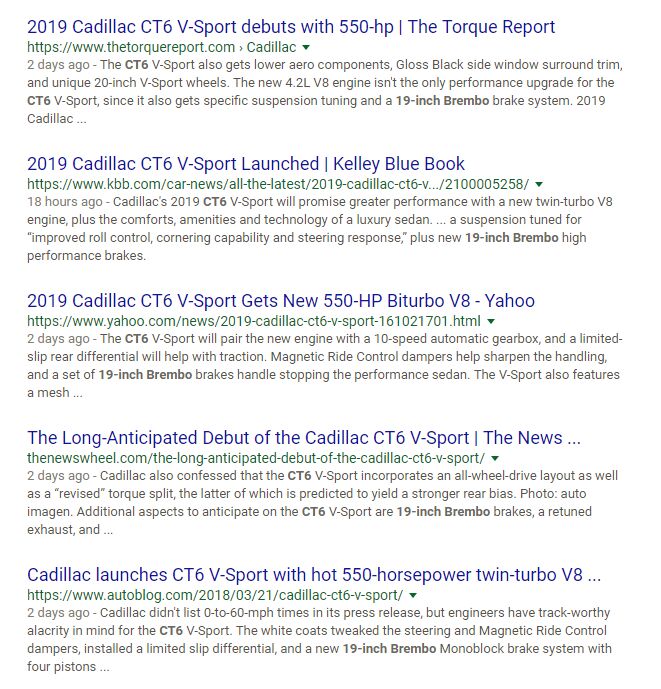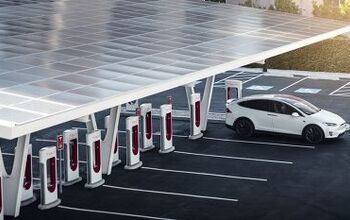No Fixed Abode: The Nineteen-Inch Mystery

As you would expect, most of the reaction to Cadillac’s announcement of the 550-horsepower CT6 V-Sport centered around its engine, a “clean-sheet” 4.2-liter V8 that is either meant to slavishly ape the current German fetish for diminutive, twin-blown bent-eights or cash in on all that nostalgia for the Northstar and its litany of opportunities for improvement. I’m not sure which.
I don’t know about you, but I think it makes sense to develop a whole new powerplant for the CT6 because, if there is one thing that GM does not already have, it is an exhaustively developed, amazingly compact, remarkably lightweight, and impressively powerful V8 engine. Honestly, the whole thing reminds me of the time that I accidentally bought a used DVD of “Cloverfield” at a Blockbuster Video sale only to get home and discover that not only did I already own a used DVD of Cloverfield, the one I’d just bought had a big scratch in it. Oh well. If nothing else, this new CT6 V-Sport will increase the alacrity with which the tatted-up part-time-barista grandchildren of Boomers await their death and subsequent estate distribution. Grandpa might have left you the ’57 Strat, but he left me that wacky thing that looks like a normal Cadillac Escalade but sits really low on the ground for some reason!
The Son O’ Northstar wasn’t the only technological innovation reported in the press release, however. When the CT6 V-Sport hits the streets, it will feature the largest front brakes ever fitted to a production automobile, eclipsing the 17.3-inch rotors of the Lamborghini Urus with a 19-inch system sourced from Brembo. Even more surprisingly, the whole thing fits snugly inside 20-inch wheels. This new innovation was reported across hundreds of media outlets in the automotive, business, and popular-interest press.
There is just one little issue: it can’t be true.
And why can’t it be true? Who says domestic cars can’t lead the way in braking? After all, the C6 ZR1 used carbon-ceramic discs that were similar in size and composition to the ones that debuted on the Ferrari FXX hyper-hyper-super-car. It even came with special brake booties to use during servicing. So let’s not get all bigoted about this idea that only Italian exotics or German bruisers can sport world-class stopping power, alright?
In the case of the V-Sport brakes, however, it’s less a matter of bigotry than it is of mechanical engineering. With a few wacky and wonderful exceptions, such as the Sbarro Orbital Wheel, disc brakes tend to be clamped by calipers that surround the outer edge of the disc at one point.
As you can see, if you want to fit a wheel over a set of brakes it’s not enough for them to be bigger than the rotors. They also have to be big enough to clear the calipers. This is one of the major reason that today’s wheels are just so darned big; they have to fit over big brakes. In order for Cadillac to fit 19-inch rotors inside 20-inch wheels, they would have to create a set of calipers that extend less than half an inch past the discs. This is theoretically possible, but it amounts to some very tricky on-the-edge engineering and I’ve never seen anything that would come close, even in Formula One or on high-performance motorcycles. The clearance issue is a big enough deal that when Wilwood was able to make 12-inch discs fit in 15-inch wheels it was treated as serious news in the vintage-car community.
It’s highly unlikely that Cadillac has managed to fit anything more than a 15.3-inch rotor in the CT6. Sixteen inches, maybe, although that would be expensive to say the least. Nineteen inches is outside the realm of possibility, unless they’ve completely reinvented the caliper brake. That would be awesome, but it would also break the bank on a car that can’t afford to be the most expensive vehicle in the segment. So here’s the question: Why did hundreds of outlets report the 19-inch brakes without a moment’s worth of critical thinking?
To my knowledge, the only person who read the press release and actually thought about it was our own Bozi Tatarevic, who then alerted me to the problem. I read the press release for myself and sure enough, it was claiming 19-inch brakes. It’s obviously a typo, but how did it slip by so many people, both inside GM and out in the so-called real world?
You can blame it on a historically unprecedented level of ignorance among the automotive press. Forty years ago, the “buff book” writers were often credentialed engineers and auto-industry veterans like Patrick Bedard or frustrated club racers like (insert a dozen names here). As recently as the turn of the century the vast majority of people who wrote about cars had some nontrivial hands-on experience with them, even if it was just changing their own oil and rotating their own tires.
We are no longer in that particular part of Kansas, Toto. Many of the most prominent writers and “influencers” live in New York apartments. Some of them have never owned a car. A major percentage of the modern spend at a new-vehicle release goes to social-media celebrities, travel journalists, and other people who have no genuine interest in, or knowledge regarding, automobiles. They’ve never changed brake pads or even changed a flat tire. How could they know that a 19-inch rotor won’t fit inside a 20-inch wheel?
To further complicate issues, we have gone from a monthly news cycle to an hourly news cycle with a voracious appetite for what we non-judgmentally call “content.” That CT6 press release was just another piece of content. Sites like Jalopnik, Autoblog, and even TTAC are now dependent on a revenue model where they take daily press releases and re-phrase them for general consumption. There isn’t time to devote real attention or thought to that content. It doesn’t pay any better and the readers won’t reward you for doing so.
That’s how you get three hundred news stories about magic brake rotors. Everybody needs news, nobody has the time to proofread it, and very few people have the knowledge that would be required in order for said proofreading to be useful. Moreover, as we saw with Buick’s embarrassingly illiterate response to our Death Watch piece two weeks ago, the automakers are increasingly putting their PR and social-media presence in the hands of people who are, to be brutally frank, not grown-up enough to do the work.
What’s the end result of all this? I’m afraid that it’s yet another area in which the consumer is being asked to shoulder additional responsibility. You’ll be doing your own-fact checking the same way you handle all of your own bank transactions via ATM or phone app, deal with your travel reservations through clunky websites, and even order your own Quarter Pounder on a touchscreen so you can avoid having an extended interaction with an openly hostile counter person who may or may not fully grasp the language you’re speaking. Is there a better way to do it? Sure, but that better way costs money in a world where the price of automotive news has generally settled around the $0.00 mark. When it comes to making a choice between good and cheap, Americans have overwhelmingly picked the latter over the former.
Let’s hope that the brakes on the CT6 V-Sport are better-sorted than the press release is. Or maybe it’s all an early April Fools’ prank and the CT6 will really have that 6.2-liter small-block and, oh, I don’t know, a stainless-steel roof. If we’re going to dream, let’s dream big. And if we’re going to make up 19-inch rotors, why not make up a new generation of indecently rapid Broughams under which they might be fitted?

More by Jack Baruth
Latest Car Reviews
Read moreLatest Product Reviews
Read moreRecent Comments
- Lou_BC Well, I'd be impressed if this was in a ZR2. LOL
- Lou_BC This is my shocked face 😲 Hope formatting doesn't fook this up LOL
- Lou_BC Junior? Would that be a Beta Romeo?
- Lou_BC Gotta fix that formatting problem. What a pile of bullsh!t. Are longer posts costing TTAC money? FOOK
- Lou_BC 1.Honda: 6,334,825 vehicles potentially affected2.Ford: 6,152,6143.Kia America: 3,110,4474.Chrysler: 2,732,3985.General Motors: 2,021,0336.Nissan North America: 1,804,4437.Mercedes-Benz USA: 478,1738.Volkswagen Group of America: 453,7639.BMW of North America: 340,24910.Daimler Trucks North America: 261,959





































Comments
Join the conversation
Given that the inner barrel is smaller diameter than the outer rim where the bead of the tire is the 19" rotor would not fit even if they clamped down with the pistons inside the diameter of the rotor unless the rotor is part of the rim. No amount of offset can fix that issue either unless the offset is far greater than half the width of the wheel. Don't see that happening as it would totally screw the scrub and geometry.
Actually, it can be true. Notice that they said the car had 19" brakes. They didn't claim to have 19" rotors. While it is correct that a brake package using a 19" rotor would never fit inside a 20" wheel, the designation '19 inch brake' refers to a brake system that is designed to fit in a 19 inch wheel. Obviously it will also fit in a 20 inch or larger wheel, but an 18 inch wheel will not fit over a 19 inch brake.